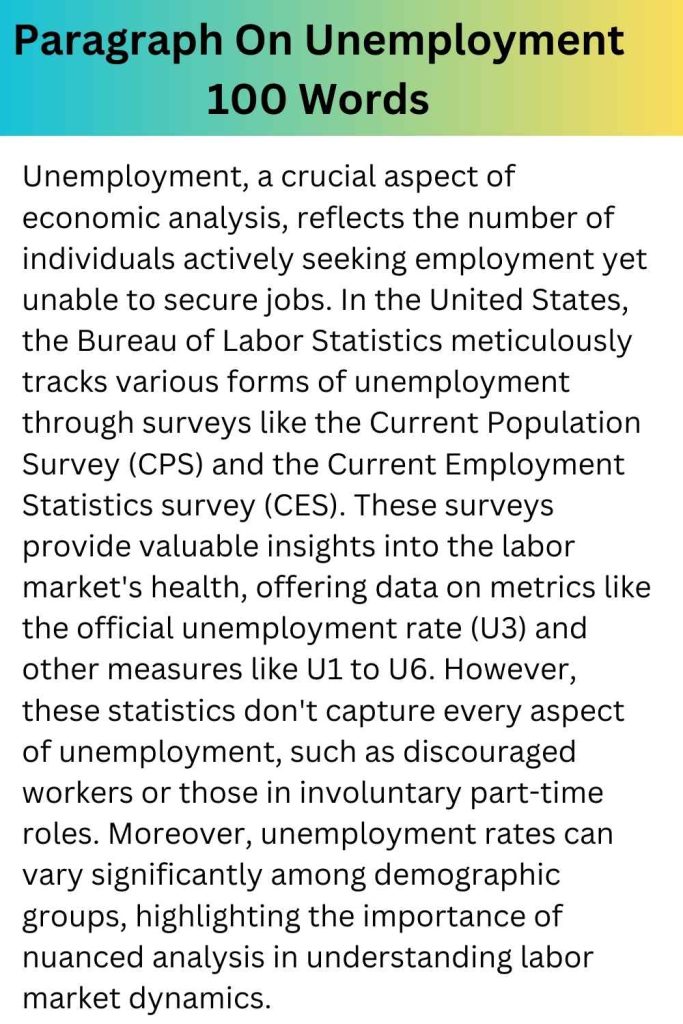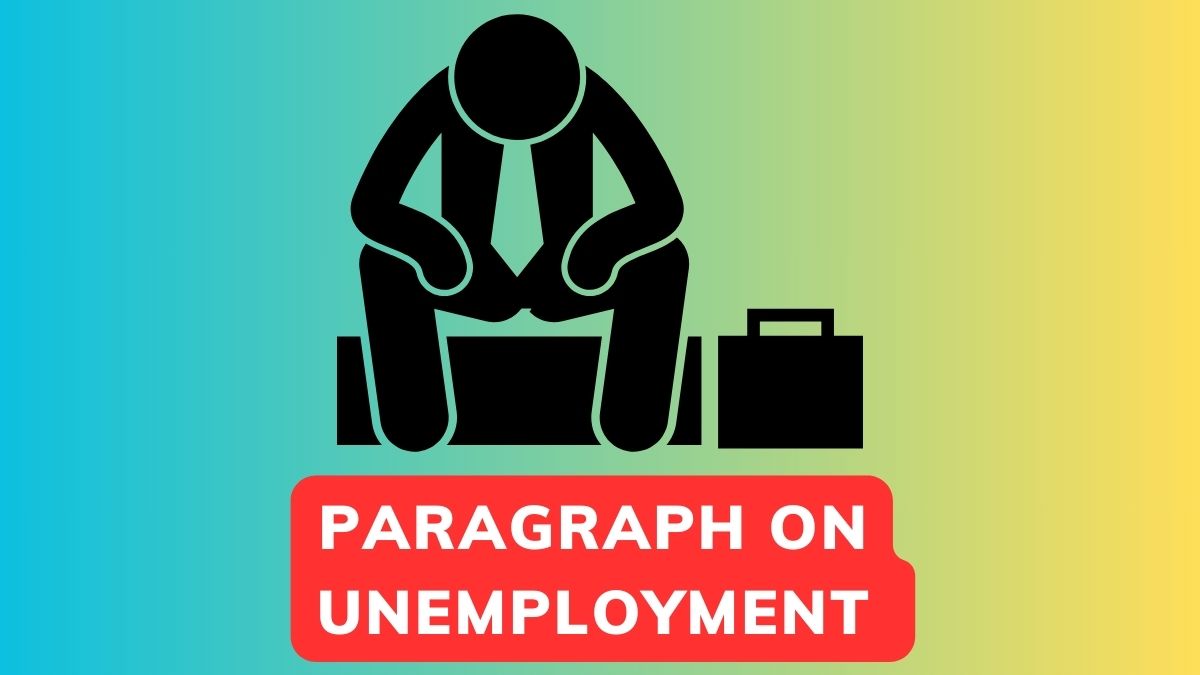Paragraph On Unemployment In English 100-250 Words
Paragraph On Unemployment 100 Words
Unemployment, a crucial aspect of economic analysis, reflects the number of individuals actively seeking employment yet unable to secure jobs. In the United States, the Bureau of Labor Statistics meticulously tracks various forms of unemployment through surveys like the Current Population Survey (CPS) and the Current Employment Statistics survey (CES). These surveys provide valuable insights into the labor market’s health, offering data on metrics like the official unemployment rate (U3) and other measures like U1 to U6. However, these statistics don’t capture every aspect of unemployment, such as discouraged workers or those in involuntary part-time roles. Moreover, unemployment rates can vary significantly among demographic groups, highlighting the importance of nuanced analysis in understanding labor market dynamics.
Paragraph On Unemployment 100 Words PDF

Paragraph On Unemployment 150 Words
Unemployment, a significant economic indicator, refers to the state of being without a job despite actively seeking employment. In the United States, unemployment rates are measured through various surveys conducted by the Bureau of Labor Statistics. These surveys, such as the Current Population Survey and the Current Employment Statistics survey, provide insights into different aspects of unemployment, including long-term unemployment and underemployment. While the official unemployment rate, known as U3, captures individuals actively looking for work within the past four weeks, other measures like U6 encompass a broader spectrum of the labor force, including part-time workers seeking full-time employment. However, these statistics may not fully represent the complexity of unemployment, as they do not account for certain groups like the incarcerated population or those who have become discouraged from job hunting. Understanding unemployment trends is crucial for policymakers and economists to formulate effective strategies for addressing workforce challenges and fostering economic growth.
Paragraph On Unemployment 200 Words
Unemployment remains a significant economic challenge, impacting individuals and communities across the United States. Defined as the absence of jobs for those actively seeking employment, it’s a multifaceted issue with various dimensions. The United States Bureau of Labor Statistics meticulously tracks and reports unemployment rates through surveys and data collection efforts. These efforts help in understanding the dynamics of employment trends and their implications. Unemployment rates can vary by region, demographic groups, and economic conditions, painting a diverse picture of the job market. Additionally, alternative measures like U1 to U6 provide nuanced insights into different aspects of unemployment, including long-term unemployment and underemployment. While statistics offer valuable insights, they may not fully capture the complexity of the situation, as some individuals may not be counted in official measures, such as discouraged workers or those in part-time roles seeking full-time employment. Furthermore, societal factors, such as changes in labor force participation rates among women, add layers to the discussion. Understanding and addressing unemployment requires comprehensive strategies that consider economic, social, and policy factors to foster inclusive and sustainable growth.
Paragraph On Unemployment 250 Words
Unemployment, a critical aspect of any economy, represents the percentage of individuals actively seeking employment but unable to secure jobs. In the United States, unemployment rates are meticulously measured through various surveys conducted by the Bureau of Labor Statistics (BLS). These surveys, namely the Current Population Survey (CPS) and the Current Employment Statistics survey (CES), provide insights into different facets of unemployment, such as the duration of unemployment, reasons for job loss, and underemployment. The unemployment rate, often referred to as the U3 rate, signifies the proportion of the labor force without jobs but actively seeking work within the past four weeks. However, this official measure doesn’t fully capture the complexity of unemployment, as it doesn’t include discouraged workers, part-time workers seeking full-time employment, and marginally attached workers. Furthermore, disparities exist among demographic groups, with varying unemployment rates for men, women, and different racial and ethnic communities. Unemployment statistics also face challenges due to the exclusion of certain groups, such as prisoners, retirees, and individuals with disabilities, from the labor force calculation. Despite these limitations, understanding unemployment rates is crucial for policymakers and economists to gauge the health of the labor market and implement targeted interventions to mitigate its adverse effects on individuals and society as a whole.
Unemployment Paragraph In English
Unemployment, a significant economic indicator, reflects the portion of the workforce actively seeking employment but unable to find suitable jobs. In the United States, the Bureau of Labor Statistics diligently measures unemployment through various surveys, such as the Current Population Survey and the Current Employment Statistics survey. These surveys offer insights into different aspects of unemployment, including long-term unemployment, discouraged workers, and part-time workers seeking full-time employment. The unemployment rate varies across demographics and regions, highlighting disparities among groups. While the official unemployment rate captures those actively seeking work, it may not fully represent all individuals affected by joblessness, such as those who have given up looking for work or are underemployed. Understanding unemployment involves considering factors like labor force participation rates and the evolving role of women in the workforce over time. Despite its limitations, unemployment remains a crucial metric for assessing economic health and guiding policy decisions.







